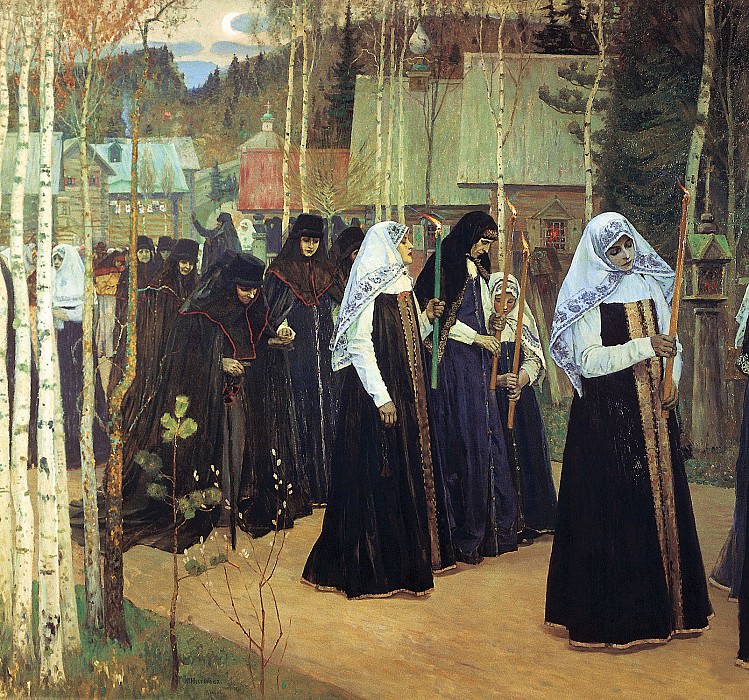Great tonsure Mikhail Nesterov (1862-1942)
Mikhail Nesterov – Great tonsure
Edit attribution
Download full size: 1604×1500 px (0,7 Mb)
Painter: Mikhail Nesterov
Quite often the painter Nesterov turned to religious themes. Here, too, he did not betray himself, but simply hid his feelings under this canvas. What are these feelings, you ask? Everything is explainable: just once the artist fell in love, at first sight, like a stroke of lightning, like a hurricane of passion. And it was mutual. And just as things were about to get married, he was suddenly rejected. Not only that, it was rejected not in person, but by a banal letter.
Description of Mikhail Nesterov’s painting The Great Revelation
Quite often the painter Nesterov turned to religious themes. Here, too, he did not betray himself, but simply hid his feelings under this canvas.
What are these feelings, you ask? Everything is explainable: just once the artist fell in love, at first sight, like a stroke of lightning, like a hurricane of passion. And it was mutual. And just as things were about to get married, he was suddenly rejected.
Not only that, it was rejected not in person, but by a banal letter. It was a blow and Nesterov created this painting under the impression of it. Although what does the rejected love and the image of nuns have to do with it... But that’s exactly how he hid his feelings. He hid his love in a nunnery.
On the canvas is a procession of nuns for the tonsure. Those wearing a white shawl are not yet nuns, but they are already at the very goal. One of the white shawl nuns is walking ahead confidently and is already immersed in prayer, in her sacrifice. She is followed by another girl, but it seems that she is still in the world, all in passions, and in the eyes still no obedience to fate.
And next to a woman who has long since obeyed fate and took monastic vows, and on the side next to her is a girl who does not yet understand the world, and here not all is accepted and made sense of it. And behind them are nuns of different ages, which are led under the arms of a beautiful statuesque woman - the abbess.
Masterfully set out plot, masterfully presented a kind of conflict between man and nature. Look at how well the spring nature and the mood of the people is contrasted. But at the same time it is still a requiem, an artistic requiem for the failed love of the artist.
Nesterov saw fit to pour out his suffering in this way, and for this we are grateful to him. Because we got a true masterpiece of the Russian school of painting, which has no equal in the world. And by the power of perception it is priceless, because only a Russian man can understand a Russian man: his despair, his grief, his love.
Кому понравилось
Пожалуйста, подождите
На эту операцию может потребоваться несколько секунд.
Информация появится в новом окне,
если открытие новых окон не запрещено в настройках вашего браузера.
You need to login
Для работы с коллекциями – пожалуйста, войдите в аккаунт (open in new window).



















COMMENTS: 1 Ответы
МОНАСТЫРЬ
1
Жизнь в монастыре, как схема жёсткая,
Жизнь, как лом обнажена, и всё
Смыто наносное, злое, косное,
Чтобы сад открылся всей красой.
2
Розовый свет на синей
Глади, ребристой слегка.
Закат тонким цветом линий
Воду вокруг островка
В чудо сейчас превращает.
На острове монастырь
Незримым огнём пылает
Ответно в небесную ширь.
3
Деревянный на острове монастырь.
Синяя, глубока, вода –
Синие ж небеса – беспредельна ширь
Для выбравших монастырь – навсегда.
Быт ниже скромного, порой и вода
Тут еда. Сколь поэтичен пост.
Грехи душу палят. Вот беда.
Сады церковных книг вдохновляют мозг.
Распорядок служб византийски-строг.
Лопнувшие шары суеты, тщеты.
А я бы так жить как ни хотел, не смог –
Да ведь и не хотел никогда ты.
You cannot comment Why?